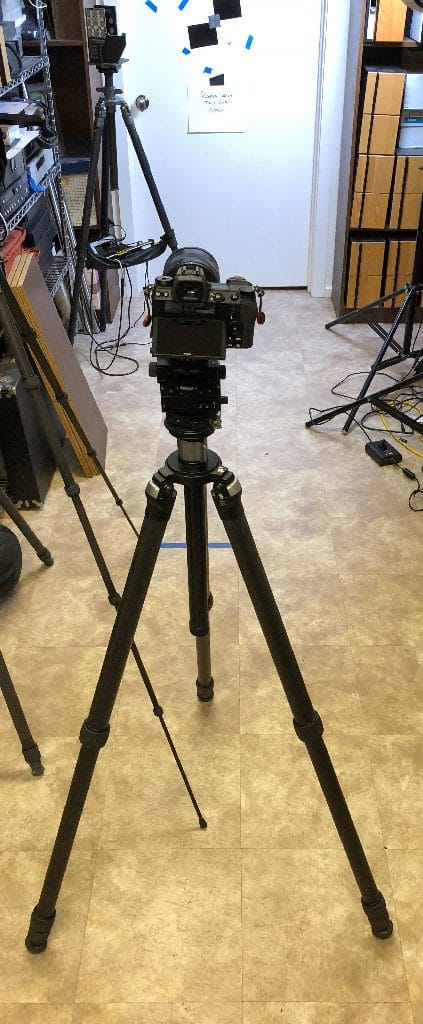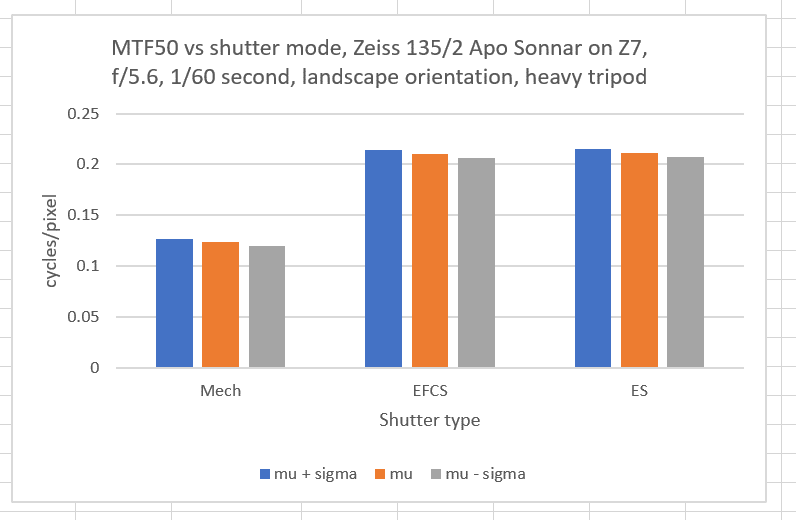This is one in a series of posts on the Nikon Z7. You should be able to find all the posts about that camera in the Category List on the right sidebar, below the Articles widget. There’s a drop-down menu there that you can use to get to all the posts in this series; just look for “Nikon Z6/7”.
I received a lot of grief for my previous post on Z7 shutter shock because of the light tripod I chose and the portrait orientation I used to demonstrate the effect. It reminded me of the bad old a7R days, when there was a continual chorus of folk saying that with a decent tripod and “good technique” — whatever that means in this case — shutter shock was never a problem.
I put a Zeiss 135 mm f/2 Apo-Sonnar ZF.2 on a FTZ adapter and attached it to the Z7. I set the aperture to f/5.6, and the shutter speed to 1/60. In the past, with the support arrangement you see below on other MILCs, that shutter speed is lower than the worst-case shutter speed.
For camera support, I stacked the deck in the other direction:
- Nice heavy set of RRS legs, and we’re only using two sections.
- No column extension
- Landscape orientation
- Good solid Arca Swiss C1 head.
- Vinyl tile over 8 inches of concrete on grade.
- 1 mile from the nearest road.
I focused and made 32 exposures 3 seconds apart using the built-in intervalometer with the mechanical shutter, with EFCS, and with the electronic shutter (ES) with IBIS set off in all cases. I developed the images in dcraw and computed the MTF50 values in cycles per pixel for the horizontal slanted edges. Then I computed the average and standard deviation for all three shutter modes. Here are the averages (aka mu values), and the average plus one standard deviation (mu + sigma) and the average minus one standard deviation (mu – sigma) values.
The mechanical shutter did a bit better than with the light tripod when compared to EFCS and ES, but it’s still quite a bit worse than those modes.
The lesson is the same as before:
Don’t use the Z7 mechanical shutter unless you want shutter speeds faster than 1/2000, or you’re concerned about the bokeh effects of EFCS.


Jack Hogan says
Good one Jim. Can we say that one should expect virtually identical performance from the two modes when shooting hand held?
JimK says
The modes being mechanical and EFCS? That was not the case with the a7R. I seriously doubt if it is the case with the Z7, which has even higher resolution. The sigmas will go up in both cases, though, so for a single pair of images it might not make a difference.
Jack Hogan says
Ok thanks.
JimK says
There’s hardly ever a downside to using EFCS, so why not embrace it?
Richard says
Hello, I wonder if you have considered testing with “exposure delay” (d4)? If the delay is added between winding the shutter and opening the front curtain (the reference manual doesn’t give much detail about it), maybe it would reduce the shutter shock slightly (but not to EFCS levels).
JimK says
My first experiment with that showed only moderate improvement. Maybe I’ll go back and look again, but I think the plan for now is to simply use EFCS as the default.
Artur says
“Don’t use the Z7 mechanical shutter unless you want shutter speeds faster than 1/2000, or you’re concerned about the bokeh effects of EFCS.”
Bokeh effects of EFCS? Please explain 🙂
I always use EFCS when possible but wasn’t aware that it would affect bokeh.
Always learning hey.
JimK says
Comes from the fact that the first and second “curtain” aren’t in the same plane. Not significant most of the time.
https://blog.kasson.com/the-last-word/efcs-and-bokeh-a7rii-with-sony-902-8-macro/
https://blog.kasson.com/the-last-word/efcs-and-bokeh-a7rii-with-otus-851-4/
terry stahly says
I am confused when I see what I think are very similar results for EFCS and ES which I presume is silent shutter?
I read where the a7rIV has only 7 FPS with silent shutter will EFCS permit a faster or full 10FFS on the A7rIII or IV?
Is there any reason not to use EFCS your blog here says not really. Why is this not more well known and practically standard fare if it is better? Surely knows or you would at think they would know and publicize this they want the best result for their customers as possible.
JimK says
Why is that confusing? Most of the shutter shock comes from the winding of the shutter prior to the exposure. Some comes from the first curtain. EFCS eliminates both of those. ES eliminates shock from the second curtain, which is usually not an issue for single shots.
I wouldn’t use EFCS for a series of shots with close temporal separation, since the shutter is wound and opened after every shot and that can upset shots after the first one. There are also some rare bokeh issues with EFCS, since the two curtains aren’t in the same plane. Also, at high speeds (faster than 1/1000 seconds), EFCS can provide uneven exposure.
it’s a mystery to me; I’ve been writing about it for years. Any why the default shutter mechanism for the Zx cameras is full-mechanical seems crazy to me. That will probably change now that Nikon offers “auto” shutter mode.